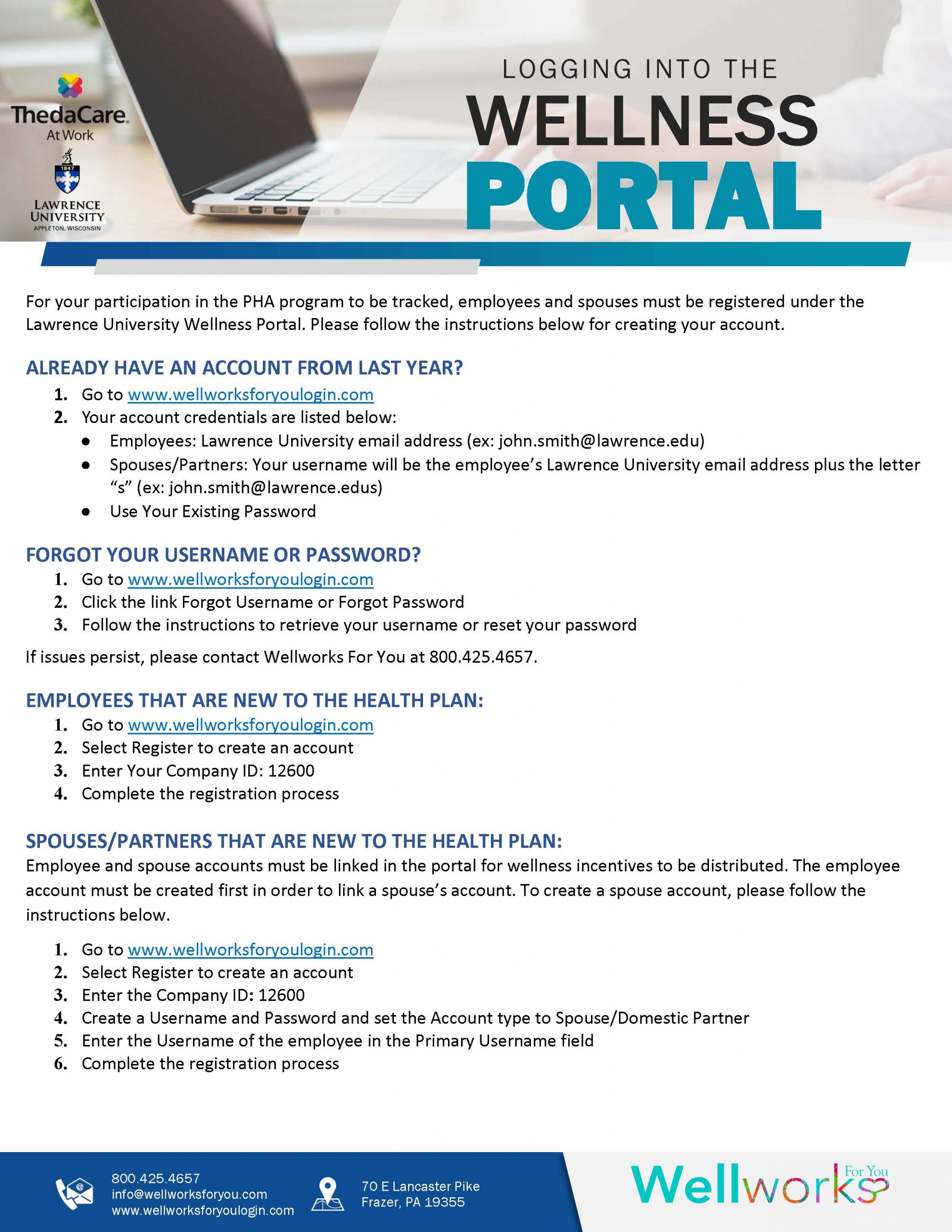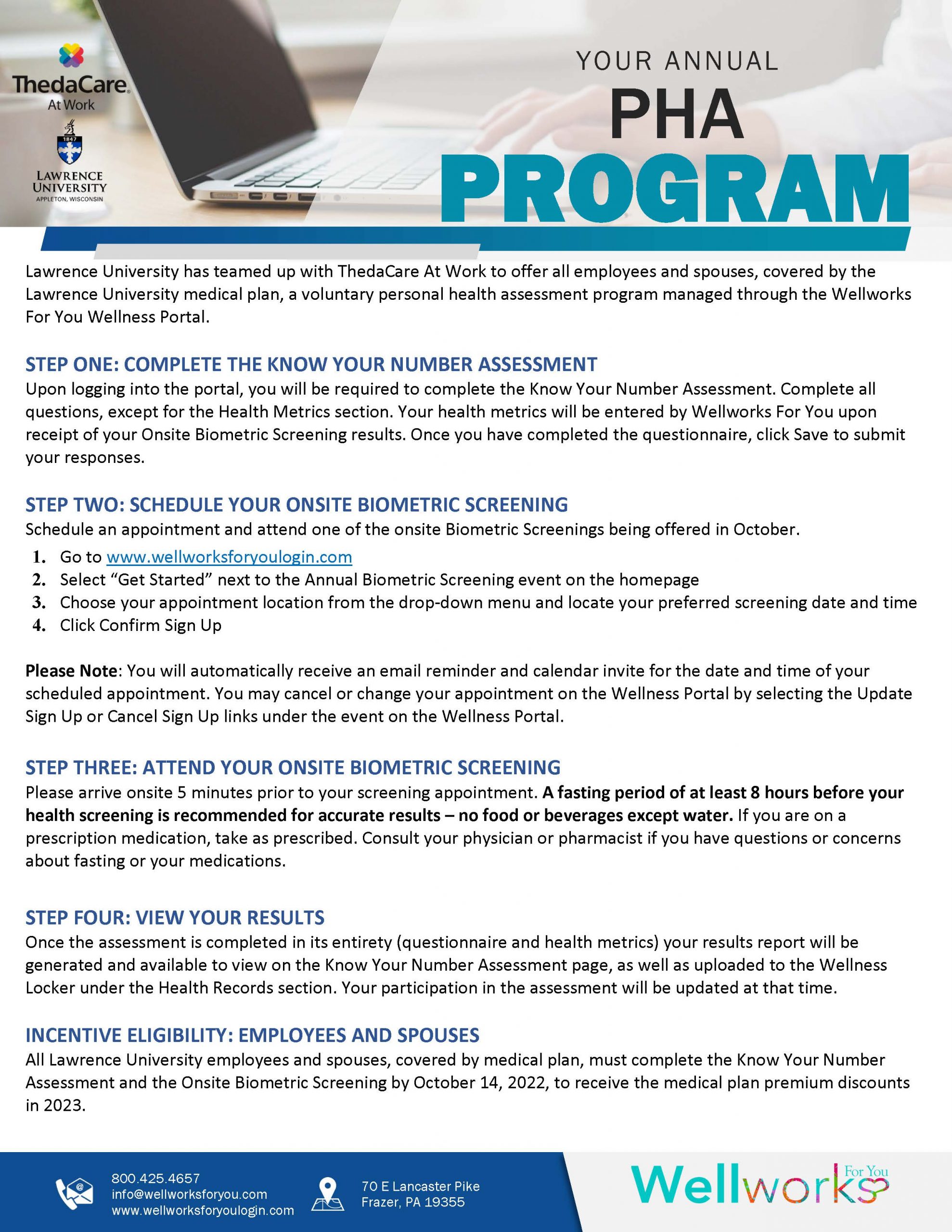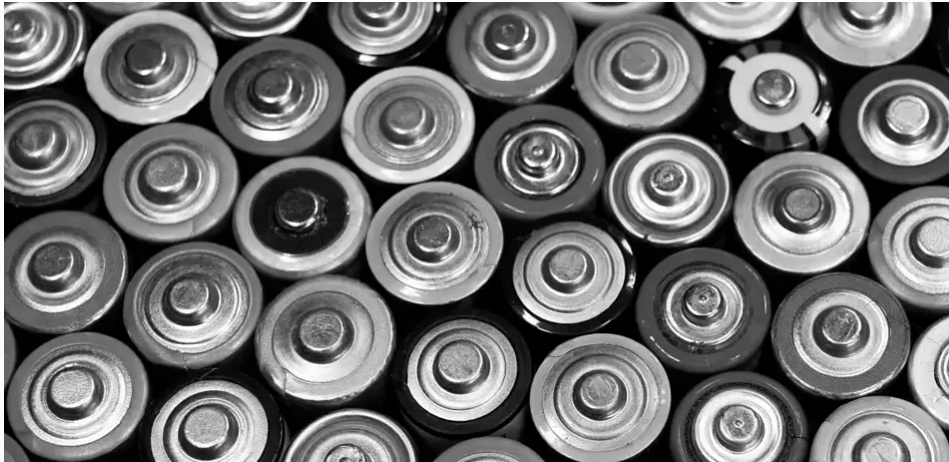When: Tuesday, October 11, 2022 – 11 AM to 2 PM
Where: Warch Center, Pusey Room 325
Bring your vaccination card.

When: Tuesday, October 11, 2022 – 11 AM to 2 PM
Where: Warch Center, Pusey Room 325
Bring your vaccination card.
Appointments are still available to complete your PHA.
Who is eligible to participate?
All staff and faculty are welcomed and encouraged to participate in the PHA process. Participation is also encouraged for the following individuals covered under the Lawrence University medical plan: spouses/domestic partners of employees, retirees, and spouses/domestic partners of retirees.
Note for Medical Plan Participants
Participation by employees, retirees covered under the medical plan, and spouses/domestic partners covered under the medical plan will provide the discounts to the medical plan premium. All participants must complete both the biometric screening and the know your numbers questionnaire to receive the premium discount. The questionnaire can be completed through Wellworks portal (ThedaCare’s new platform) while signing up for your biometric screening appointment. Discounts are provided based upon participation and are not scoring, or results based.
ThedaCare will again utilize a finger stick blood collection as opposed to an arm draw. This process is less invasive and provides instant results.
If you or your spouse/domestic partner is pregnant or within 6 months post-partum during the time of the assessments, participation by the pregnant/post-partum individual will not be required to obtain the discounts on medical plan premiums. Human Resources must be notified if this is applicable to you or spouse/domestic partner by October 14, 2022.
How do I sign up?
Scheduling directions can be found in the attached Annual PHA Program and Logging into the Wellness Portal documents or click here to sign up: www.wellworksforyoulogin.com. The PHA schedule books quickly. To ensure you receive your preferred appointment time, do not delay in scheduling your appointment.
What is the PHA schedule?
All appointments will be held in the Warch Campus Center – Hurvis & Mead Witter rooms. Appointment time and dates are as followed:
Please contact your HR Representative if you have any questions regarding the PHA process including scheduling your assessment.
Thank you,
Human Resources


Pre Giving Day Tie-Dye Party – Monday, Oct. 24
Note: The date of this event has changed to Oct. 24: To get campus ready for the 9th annual Giving Day celebration, the Philanthropy Engagement Center will be hosting a tie dye event on Monday, Oct. 24 from 4:30 to 5:30 pm outside of Ormsby Hall.
There will be 100 Giving Day t-shirts that are exclusive to this event available for students to make their own tie-dye creations. In the event of rain, the event will take place in the Somerset Room in the Warch Campus Center.
Giving Day is set for Wednesday, Oct. 26.
In this #FDNYSmart video, Captain Michael Kozo shares important safety tips that will help raise awareness of the safe ways to charge, store, and dispose of rechargeable and lithium-ion batteries or the devices powered by them.

FDNYSmart Safety Tips for Devices with Lithium-Ion Batteries
Lithium-Ion batteries are used in various devices. These batteries are commonly used in cell phones, laptops, tablets, electric cars, and scooters. Lithium-ion batteries store a large amount of energy and can pose a threat if not treated properly. Like any product, a small number of these batteries are defective. They can overheat, catch fire, or explode.
Be #FDNYSmart if using any devices powered by lithium-ion batteries:
Battery Disposal:

Blue & White Homecoming Weekend is here! It’s time for all Lawrentians – students, faculty, staff, alumni, and families – to share their Viking pride and celebrate our 175 year history.
Blue & White Homecoming Weekend October 6-9, 2022
See the full Blue & White Homecoming Weekend Schedule

Get your Lawrence gear!
Whether you are here on campus or celebrating from afar, show your school spirit by proudly wearing your LU gear or our beloved school colors: Blue & White. In need of some new LU gear? Stock up at our Vikings Online Store or our special 175th anniversary store.
T-shirt Giveaway
The Blue & White Homecoming T-Shirt Giveaway will take place on Thursday, October 6 from 12-1:30 p.m. on the third floor of the Warch Campus Center, outside the Kraemer Conference Room
Follow along online
Can’t attend in-person? Follow us all weekend long on Facebook and Instagram. Use #LUHOMECOMING22 to share stories and images of your own celebrations.
Fall Preview Concert
Friday, October 7: 8-9 p.m., Lawrence Memorial Chapel. In addition to the return of our beloved Kaleidoscope, we’re thrilled that the choir is giving us a sneak peek of their work with this fall preview concert.
Vikings Tailgate
Saturday, October 8: Tailgate: 11 a.m.–12:30 p.m., Lawrence vs. Cornell Football Game: 1-4 p.m. Banta Bowl. Experience the Fan Zone at this pre-football tailgate!
*Credit/debit payment required for select offerings.
Kaleidoscope
Saturday, October 8: 8–9:15 p.m., Fox Cities Performing Arts Center, 400 W. College Ave., Appleton. First performed in 2006, Kaleidoscope’s nonstop, 75-minute format provides a rapid-fire musical spectrum showcasing the sheer variety and mastery of students attending the Lawrence University Conservatory.
*Tickets required. Purchase tickets here.
Tennis, Cross Country, and More!
Saturday, October 8: See cross country teams at Reid Golf Course at 11 a.m. and women’s tennis at the Lawrence Courts at 3 p.m. And football at the Banta Bowl at 1 p.m.
12 to 1 p.m. Oct. 4: Bring your lunch to Kraemer (Warch 308) and learn how the Title IX process works on campus. Dessert/drinks will be provided.
Lawrence’s annual Giving Day is set for Wednesday, Oct. 26, and organizers are looking for Lawrence faculty and staff to help out. You know Lawrence University like no one else. We believe your voice in support of Giving Day will carry a lot of weight. That is why we are asking our faculty and staff to become Giving Day Ambassadors.
Ways that you can be a Giving Day Ambassador: Spread the word by posting on social media, texting, emailing, or calling your LU connections asking them to support Giving Day; participate in the Giving Day Challenges on the Lawrence Facebook and Instagram pages; wear your Giving Day T-shirt (more information on that below) to campus events; talk about Giving Day in your classes.
As a thank you, we will gift you with a LU Giving Day shirt to show off your school pride on Giving Day and beyond. If you’re ready to help, just fill out this simple form, and we will get in touch with you on how you can help. Please note we will need to receive the completed form by Sept. 25 to get the T-shirt to you in time for Giving Day.
7th Annual Indigenous Peoples’ Day Celebration 2022
Main Hall Green October 10, 2022 5-7 p.m.
Free and open to the public. All ages welcome.
Many cities and states across the United States have replaced the Columbus Day holiday with the official recognition of Indigenous People’s Day. Lawrence University welcomes the entire Fox Cities community to join us in celebrating and learning about the many contributions of Indigenous people globally through song, dance, food, and local Native American guest speakers/leaders.
Featuring:
-Opening Prayer: Dennis Kenote, Menominee elder
-Singing performance by Appleton Area School District high school students
-Guest Speaker: Ron Corn Sr, Tribal Chairman of the Menominee Nation
-Drumming Dreams guided meditation by Navajo artist and community healer Kristina Nez Begay
-Native American & Hawaiian music, singing, and dancing demonstrations
-Indigenous food provided throughout the event
Rain site: WCC/Somerset
Sponsored by LUNA (Lawrence University Native Americans) AASD (Appleton Area School District) D&IC (LU Diversity & Intercultural Center) S&RL (LU Spiritual & Religious Life) and NEH (National Endowment for the Humanities)
We collectively acknowledge that Lawrence University is situated on the ancestral homelands of the Menominee and Ho-Chunk people.

The Center for Community Engagement & Social Change and the City Clerk of Appleton have partnered to provide three on-campus voter registration opportunities in advance of the Nov. 8 election.
Location: Mead Witter Room, Warch Campus Center
Tuesday, September 27 – 9am-1pm
Wednesday, September 28 – 1pm-5pm
Monday, October 3 – 10am-1pm
Election Transportation:
Get a ride to the polls! On Election Day (Tuesday, November 8) there will be shuttles going to our polling location from 7am to 8pm! Shuttles will be leaving from Wriston Turnaround all day long!
If you are interested in being a paid shuttle driver, please email the CCE (community.engagement@lawrence.edu).
Planning to get there on your own? Our polling location is St. Joseph’s Parish (404 W. Lawrence St., Appleton, WI 54911).
All staff are invited to kick off the new academic year in delicious style – with coffee and pastries provided by Staff Council.
Stop by Thursday, September 29, from 7:45 a.m. to 9 a.m. in the Harper-Shattuck Lobby in the Conservatory. Grab a coffee and your favorite sweet treat to go or stay and meet old colleagues and greet new ones!
We hope to see you there!